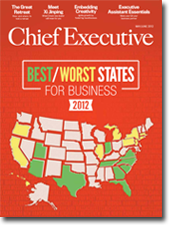Employees and Employers Benefit From Right to Work Laws

Another Triumph for Texas: Best/Worst States for Business 2012 …

The evidence is overwhelming that both employees and employers benefit from state Right to Work laws that make it illegal to force employees to pay money to an unwanted union as a condition of getting or keeping a job. Journalists often focus on the benefits to business. A very recent example is the cover story for the latest issue of Chief Executive magazine.
Early this year, Chief Executive asked hundreds of CEOs from around the country to grade the states in which they do business according to a variety of measures, including “tax and regulation, quality of the workforce and living environment.†Overwhelmingly this year, as in the past, the states given the highest overall ratings by business leaders are Right to Work states. In fact, all of the states ranked in the 10 in 2012 are Right to Work states. Seventeen of the top 20 are Right to Work states. On the other hand, not one of the 20 states with the lowest overall ratings has a Right to Work law on the books.
Chief Executive’s J.P. Donlon called attention to the strong positive correlation between Right to Work status and attractiveness to job creators in his report on the 2012 CEO survey results:
“It may be no accident that most of the states in the top 20 are also right-to-work states, as labor force flexibility is highly sought after when a business seeks a location. Several economists, most notably [Ohio University’s] Richard Vedder and Harvard’s Robert Barro, have found that economies in R-to-W areas grow faster than [in] other states, have higher employment and attract more inward migration.â€
Employees benefit from what Mr. Donlon calls “labor force flexibility†in a host of ways. The 10 Right to Work states rated as the best in the nation by Chief Executive this year (Arizona, Florida, Georgia, Indiana, North Carolina, South Carolina, Tennessee, Texas, Utah and Virginia) enjoyed an overall increase in private-sector employment of 10.6% from 2000 to 2010, according to U.S. Bureau of Economic Analysis (BEA) data. Over that same period, BEA-measured private-sector employment growth for the 10 compulsory-unionism states rated as the worst (California, Connecticut, Hawaii, Illinois, Massachusetts, Michigan, New Jersey, New York, Oregon and Pennsylvania) was just 1.9% — or less than a fifth as much.
Employees in high “labor force flexibility†states also benefit from generally lower living costs. Only one of the 10 top-ranked Right to Work states (Arizona) had a 2010 cost of living even slightly above the national average, according to data supplied by the nonpartisan Missouri Economic Research and Information Center. Arizona was approximately 4% more expensive than the average state. Meanwhile, half of the bottom-ranked compulsory-unionism states had a cost of living more than 25% higher than the national average.
Once you take such interstate differences in cost of living into account, you see as well that real compensation (including benefits and bonuses as well as wages and salaries) per private-sector employee is typically higher in the states Chief Executive calls “the best for business.†In 2010, the average cost of living-adjusted compensation for a private-sector employee in the top-ranking Right to Work states was $41,865, or nearly $900 more than the average for the bottom-ranking compulsory-unionism states.

